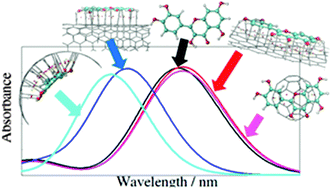Flavonol–carbon nanostructure hybrid systems: a DFT study on the interaction mechanism and UV/Vis features†
Abstract
Flavonols are a class of natural compounds with potential biological and pharmacological applications. They are also natural pigments responsible for the diversity of colors in plants. Flavonols offer the possibility of tuning their features through chemical functionalization as well as the presence of an aromatic backbone, which could lead to non-covalent interactions with different nanostructures or aromatic molecules. In this work, a protocol based on ONIOM (QM/QM) calculations to investigate the structural features (binding energies, intermolecular interactions) of flavonols interacting with the surface of several carbon nanostructures (such as graphene, fullerene C60 and carbon nanotubes) is developed. The confinement of flavonols inside carbon nanotubes has also been studied. Three flavonols, galangin, quercetin and myricetin, as well as pristine flavone were selected. Special attention has also been paid to the changes in UV/Vis features of flavonols due to the interaction with carbon nanostructures. Our results point out that π-stacking interactions are the driving force for the adsorption onto carbon nanostructures as well as for the confinement inside carbon nanotubes. Likewise, UV/Vis features of flavonols could be fine-tuned through the interaction with suitable carbon nanostructures.


 Please wait while we load your content...
Please wait while we load your content...